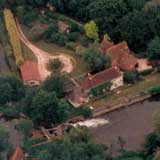

Born by the current
Links
Elaine's perspective
Projects
Publications
Speeches
Committees
Journal
CounterCurrent
What propels us
I am often asked what exactly it is that I do, whether at SustainAbility or elsewhere. Difficult. When filling in the 'Please state profession' line on passports and other forms I have long been tempted to write 'Babelfish', which I'll explain in a moment.
But for 30 years the question I have been asked most often is what first switched me on to environmentalism and, later, sustainable development? Some answers can be found in my book A Year in the Greenhouse, in the Influences and Timelines sections of this website, and in an article I wrote some time ago for Jain Spirit magazine.
And the website? It's a fairly natural outflow from work I have done under the guise of John Elkington Associates (JEA), founded by my wife Elaine and I in 1983.
The site in no way diminishes my commitment to SustainAbility, rather it provides a channel for material (some might say flotsam and jetsam) and meandering commentary that would not naturally find a home on the SustainAbility website (www.sustainability.com). Probably the most conspicuous example of that is my 'blog', which can be found on the Journal page.
Propellants
In compiling this website, with the help of Rupert
Bassett and Lynne Elvins, I was forced to plumb
my core values, powerfully shaped by pressures and opportunities described
elsewhere on the site.
Eight values that bubbled to the surface were:
Evolution Real change happens over generations
Sustainability Future generations as stakeholders today
Diversity Evolution feeds on difference
Transparency Sustainable economies are see-through
Conversation Wellspring of insight
Memory Capture lessons of experience*
Intuition Facts only get you so far
Serendipity Learn from mistakes and fortunate accidents.
These values also eddy through the visual aspects of the site, including the logo. Click here for Rupert's explanation of how the imagery evolved.
And the Babelfish?
Here's the story. My work has often run counter-current, hence the imagery
of fish swimming against the flow. At SustainAbility, too, we aim to drive
the discussion of problems upstream - from symptoms to causes - in pursuit
of real cures.
But maybe the story runs deeper still. I was born in a mill-house cottage on an island in the Kennet, a tributary of the Thames. Later, as a child, I would find myself surrounded by elvers on a moonless night in Northern Ireland, or communing with wildlife along rivers in Gloucestershire, Somerset and Dorset.
Looking back, you see links. My first major professional project involved fighting to protect part of the Nile Delta wetlands. That, in turn, led to my first article for New Scientist, in 1975. Several years of writing for New Scientist, while working with John Roberts at TEST, led directly to 1978's invitation from Max Nicholson and David Layton to co-found Environmental Data Services (ENDS). And when I left ENDS in 1983, we leveraged my experience with business to launch JEA and then, in 1987, SustainAbility.
Post-1987, JEA served as a flag of convenience for a series of book projects. The website project, however, helped refloat the vessel. And once we had decided to use fish for our new logo, the imagery proved surprisingly apt.
Fish, it turns out, symbolise reproduction, life, freedom, the emotions, our unconscious, the quest for enlightenment, flashes of intuition, prophecy, fertility, plenty, prosperity, good luck, longevity and rebirth. Salmon, the ultimate homing fish and recently returned to the upper Thames, near our London home, symbolise wisdom - vital in a world flooded with data and information.
And that's where the Babelfish fits in. Brainchild of the late, great sci-fi author Douglas Adams, it was billed as the universal translator. Slip the creature into your ear, we were told, and you could suddenly understand all the Galaxy's languages. If any one organism symbolises my aspirations, and my work across the turbulent, blurring boundaries between business, financial markets, governments and civil society, this is it.
And, finally
One ingredient that several people missed when I circulated a late draft of
the website for comment was Elaine's view on all of this, on - as Francesca
van Dijk put it - 'how you, and SustainAbility, have developed over the
years'. So Elaine's perspective is also available
on this website. By the time the site launched in 2003, she and I had been
together for 35 years and married for 30. Our ongoing conversation has been
a crucial wellspring of much of my thinking. Her constant support, in all
sorts of ways, has been key through all the ups and downs.
So my profound thanks to Elaine and to our daughters, Gaia and Hania, for their forbearance, support and advice.
John Elkington, March 2004
* Given our work over the years on such
issues as corporate reporting and assurance, some might expect to see some
sort of verification statement here. What's fact, what might be fiction? As
a form of verification, we sent out drafts of the website for comment. Changes
were made - and in some cases are noted. Interestingly, however, the science
of memory suggests that memories are far from static. The process of remembering
something can render the memory fluid, open to reinterpretation and embellishment
(John McCrone, 'Not-so total recall,' New Scientist, 3 May 2003 - and
www.newscientist.com). So the invitation
to comment is ongoing.